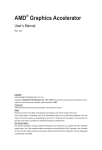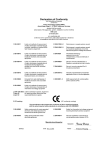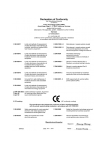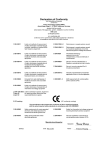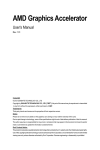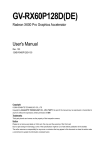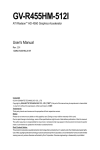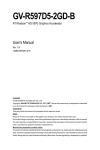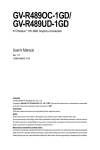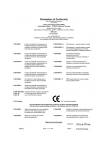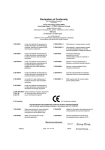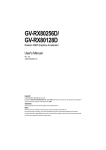Download Gigabyte Ati Radeon 2400 XT AMD
Transcript
GV-RX24T256H
ATI Radeon HD 2400 XT Graphics Accelerator
TM
User's Manual
Rev. 101
12MD-RX24T2HG-101R
Copyright
© 2007 GIGABYTE TECHNOLOGY CO., LTD
Copyright by GIGA-BYTE TECHNOLOGY CO., LTD. ("GBT"). No part of this manual may be reproduced or transmitted in any from
without the expressed, written permission of GBT.
Trademarks
Third-party brands and names are the property of their respective owners.
Notice
Please do not remove any labels on VGA card, this may void the warranty of this VGA card
Due to rapid change in technology, some of the specifications might be out of date before publication of this booklet.
The author assumes no responsibility for any errors or omissions that may appear in this document nor does the author make a
commitment to update the information contained herein.
Macrovision corporation product notice:
This product incorporates copyright protection technology that is protected by U.S. patents and other intellectual property rights.
Use of this copyright protection technology must be authorized by Macrovision, and is intended for home and other limited viewing
uses only unless otherwise authorized by Macrovision. Reverse engineering or disassembly is prohibited.
English
Table of Contents
1. Introduction ......................................................................................... 3
1.1. Features ..................................................................................................... 3
1.2. Minimum System Requirements ................................................................... 3
2. Hardware Installation ........................................................................... 4
2.1. Board Layout .............................................................................................. 4
2.2. Hardware Installation ................................................................................... 6
3. Software Installation .......................................................................... 10
3.1. Windows® XP Driver Installation .................................................................................... 10
3.1.1. Operating System Requirement ................................................................................. 10
3.1.2. DirectX Installation ......................................................................................................... 11
3.1.3. Driver Installation .......................................................................................................... 12
3.1.4. Taskbar Icon ................................................................................................................. 14
3.1.5. Display Properties pages ............................................................................................ 16
4. Troubleshooting Tips ........................................................................ 33
5. Appendix .......................................................................................... 34
Resolutions and Color Depth Table (In Windows® XP) ...................................... 34
Regulatory Statements .......................................................................... 35
GV-RX24T256H Graphics Accelerator
-2-
1.1. Features
•
•
•
•
•
•
•
•
•
Powered by ATI RadeonTM HD 2400 XT Graphics Processing Unit (GPU)
Supports PCI Express x16
Integrated with 256 MB GDDR2 memory
Supports DirectX 9.0c/10
Supports AV / S-Video / TV-Out output
Supports 1 Dual-Link DVI-I connector
Supports 1 D-Sub connector
Supports HDTV output (by adapter, optional)
Supports HDMI connector (by adapter, optional)
1.2. Minimum System Requirements
•
Hardware
- Intel® Pentium® 4 or AMD AthlonTM
- 512 MB of system memory; 1 GB or more for best performance
- Optical drive for software installation (CD-ROM or DVD-ROM drive)
•
Operating System
- Windows® Vista
- Windows® XP with Service Pack 2 (SP2)
- Windows® XP Professional x64 Edition
-3-
Introduction
English
1. Introduction
English
2. Hardware Installation
2.1. Board Layout
D-Sub Connector
(15-pin)
TV-Out
DVI-I Connector
D-Sub Output
OR
Analog LCD Monitor Analog CRT Monitor
D-Sub
Connector
(15-pin)
Y
HDTV
Pr
NTSC / PAL TV
TV-Out
Pb/AV Output
OR
Projector
DVI-I
Connector
S-Video Output
OR
Projector
NTSC / PAL TV
DVI Output
Digital LCD Monitor
D-Sub
Output
DVI-I to D-Sub
Adapter
OR
Analog LCD Monitor
Analog CRT Monitor
DVI-I to HDMI Adapter
HDMI Monitor
GV-RX24T256H Graphics Accelerator
-4-
Expansion cards contain very delicate Integrated Circuit (IC) chips. To
protect them against damage from static electricity, you should follow some
precautions whenever you work on your computer.
1. Turn off your computer and unplug power supply.
2. Use a grounded wrist strap before handling computer components. If you do not have
one, touch both of your hands to a safely grounded object or to a metal object, such as
the power supply case.
3. Place components on a grounded antistatic pad or on the bag that came with the
components whenever the components are separated from the system.
The card contains sensitive electric components, which can be easily damaged by static
electricity, so the card should be left in its original packing until it is installed.
Unpacking and installation should be done on a grounded anti-static mat. The operator
should be wearing an anti-static wristband, grounded at the same point as the anti-static
mat.
Inspect the card carton for obvious damage. Shipping and handling may cause damage
to your card. Be sure there are no shipping and handling damages on the card before
proceeding.
DO NOT APPLY POWER TO YOUR SYSTEM IF IT HAS BEEN DAMAGED ON
THE CARD.
In order to ensure your graphics card working correctly, please use official
GIGABYTE BIOS only. Use none official Gigabyte BIOS might cause problem
on the graphics card.
-5-
Hardware Installation
English
The entire Radeon HD 2000 series support HDMI output which can handle both
audio and video signals. However, audio output from the onboard audio controller or the external sound card will be disabled when HDMI output is activated.
If no need for HDMI output function, set the onboard audio controller or the external sound
card to be the default Sound Playback device to obtain audio output from your system. For
more details, refer to page 15.
English
2.2. Hardware Installation
Installing Your graphics card.
Now that you have prepared your computer, you are ready to install your graphics accelerator
card.
To remove the existing graphics card:
1. Power off the computer and monitor, then
disconnect the display cable from the back
of your computer.
2. Remove the computer cover. If necessary,
consult your computer's manual for help in
removing the cover.
3. Remove any existing graphics card from
your computer.
GV-RX24T256H Graphics Accelerator
-6-
English
To install your new graphics card:
1. Locate the PCI Express x16 slot. If
necessary, remove the metal cover from this
slot; then align your graphics card with the
PCI Express x16 slot, and press it in firmly
until the card is fully seated.
* Please make sure that the gold edge connector of the graphics card is securely inserted.
2. Replace the screw to fasten the card in place,
and replace the computer cover.
3. Plug the display cable into your card; then
turn on the computer and monitor. If your
graphics card came with a DVI-I connector,
you can connect a flat panel display to the
appropriate connector. Or use the DVI-I-toHDMI adapter to connect an HDMI monitor.
To D-Sub Monitor
To TV/VCR
To Flat Panel Display
Connect an HDMI monitor via
DVI-I to HDMI adapter
You are now ready to proceed with the installation of the graphics card drivers. Please refer
to next chapter for detailed instructions.
-7-
Hardware Installation
English
GIGABYTE Video Adapter (Optional) for Nvidia Graphics Cards
AV Out
S-Video Out
HDTV Component
(Y+Pr+Pb)
Connect to the TV-Out port
on the graphics card.
(1) Connecting HDTV
Connect your HDTV cables to the video adapter
according to the corresponding color.
(Y= Green, Pr= Red, Pb= Blue)
(2) Connecting S-Video
If your TV has a S-Video connection, connect the SVideo cable from your TV to the S-Video Out port on the
adapter.
(3) Connecting AV Output
If your TV has a Composite video connection, you can
connect the RCA cable from your TV to the AV Out port
on the adapter.
GV-RX24T256H Graphics Accelerator
-8-
1. GIGABYTE established the use of silent pipes on graphics card's thermal solution, and has been
the leading company for silent thermal solution. GIGABYTE's passive thermal solution allows
system to work perfectly in chassis with 40~50 degrees Celsius through the air flow of the system.
Please beware of the other excess component or insufficient system thermal design that may
cause high system temperature. Excess high temperature will affect the passive thermal design
and thus compromising system stability.
2. GIGABYTE TECHNOLOGY's passive thermal design effectively implemented heat exchange,
radiation and convection to improve stability of the system. Please maintain passive thermal sink
at a normal and clean environment. Extra dust on heatsink may decrease the effectiveness of the
thermal design.
Silent Thermal Technology
Passive Thermal Design
-9-
Hardware Installation
English
GIGABYTE Thermal Solution Guidelines:
English
3. Software Installation
In this manual, we assume that your CD-ROM Drive letter to be Drive D:
The installation of Windows® XP drivers is very simple. When you insert the driver CD into
your CD-ROM drive, you can see the AUTORUN window (if it does not show up, run "D:
\setup.exe"). Then you can follow the guides to setup your graphics card driver. (Please
follow the subsection 3.1.3 "Driver installation" to install the driver for your graphics
accelerator.)
3.1. Windows® XP Driver Installation
3.1.1. Operating System Requirement
• When loading the graphics card drivers for the system, please make sure your system
has installed DirectX 9.0c or later version.
• If you install the graphics card drivers for the motherboard, which consist of SIS, or VIA
chipsets, please install the appropriate driver program for that motherboard. Or please
contact your motherboard nearest dealer for motherboard driver.
GV-RX24T256H Graphics Accelerator
- 10 -
Install Microsoft DirectX to enable 3D hardware acceleration support for Windows® XP to
achieve better 3D performance.
0 Note: For software MPEG support in Windows® XP, you must install DirectX first. Users
who run Windows XP with Service Pack 2 or above do not need to install DirectX
separately.
Click the Install DirectX 9 item.
Step 1. When autorun window show up, click the
Install DirectX 9 item.
Step 2. Choose I accept the agreement
Step 3. Click the Next button.
and click the Next button.
Installing the components.
Step 4. Click Finish to restart computer.
Then the DirectX 9 installation is completed.
- 11 -
Software Installation
English
3.1.2. DirectX Installation
English
3.1.3. Driver Installation
A. New hardware found
After the graphics card is inserted into your computer at the first time, the windows will
automatically detect a new hardware in the system and pop out a "New Hardware Found"
message. The following is the step-by-step installation guide.
Step 1: Found new hardware wizard: Video controller (VGA Compatible)
Click the "Next" button to install the driver. (There
is a driver CD disk that came with your graphics
accelerator, please insert it now.)
Or click the "Cancel" button to install the driver
from AUTORUN window.
Step 2: Found new hardware wizard: Searching and installing
The wizard will search for the driver and install it automatically.
Step 3: Found new hardware wizard: Finish
Click the "Finish" button to finish the installation.
GV-RX24T256H Graphics Accelerator
- 12 -
Click the Install Display Driver item.
Step 1. When autorun window show up, click the
Install Display Driver item.
Step 2. Click Next button.
Step 3. Click Yes button.
Setp 4. Click Express or Custom icon.
Windows installings the components.
Step 5. Click the Finish button to restart computer.
Then the driver installation is completed.
- 13 -
Software Installation
English
B. Driver installation (Autorun Window)
Insert the driver CD disk into your CD-ROM, and then you can see the AUTORUN window.
If it does not show up, please run "D:\setup.exe".
English
3.1.4. Taskbar Icon
ATI Catalyst® Control Center:
After installation of the display driver, you will find an ATI Catalyst® Control Center icon
on the
taskbar's status area. The ATI Catalyst® Control Center is used to configure all your graphics card
settings. Right-click the icon to enter the ATI Catalyst® Control Center (refer to Figure 1). Or you can
right-click on the desktop and select ATI CATALYST(R) Control Center (refer to Figure 2).
Figure 1
Figure 2
GV-RX24T256H Graphics Accelerator
- 14 -
English
Configuring Audio Output
Configure the default audio output device based upon your needs.
Step 1:
Go to Start > Control Panel > Sounds and Audio Devices.
Step 2:
In the Sounds and Audio Devices Properties dialog box, click the Audio tab.
Using the picture to the left as the example, to set HDMI audio
to be the default Sound Playback device, in the Default
device box, select ATI HD Audio rear output. Otherwise,
select Realtek HD Audio output, which is the onboard
audio controller.
- 15 -
Software Installation
English
3.1.5. Display Properties pages
To access Display Properties pages, right-click on Desktop and then select Properties. The
Display Properties dialog box shows the information of display adapter, color, the range of
display area, and the refresh rate.
Settings (Resolutions and Color depth for Windows)
You may adjust the screen resolution and color quality settings in this dialog box.
You can move the slider to change the resolution.
You can click the item to change the color quality.
Click the Advanced button for adapter and setting.
Display
Matrix
Model
CRT+TV (Note)
CRT+DVI
DVI+TV
DVI+TV+CRT
HDMI+TV
HDMI+CRT
GV-RX24T256H
Yes
Yes
Yes
No
Yes
Yes
(Note) The CRT+TV configuration requires that you connect your CRT display to the DVI connector on
the card using the DVI-I to D-Sub adapter to ensure normal operation.
This configuration is not supported if the CRT monitor is directly attached to the D-Sub port on the
card.
GV-RX24T256H Graphics Accelerator
- 16 -
The Basic View is the default view when ATI Catalyst Control Center is launched for the first time. This
interface provides access to the basic settings and advanced features of your ATI graphics products.
You can switch between Basic View and Advanced View at any time.
To access more settings in Basic View , click
Basic, and then click Next.
Easy Setup Wizards:
Choose a wizard from the central list and click Go for step-by-step assistance.
Avivo Video Converter
This wizard assists you to convert videos from one file format to another.
Step 1: Select Avivo Video Converter,
then click Go.
Step 2: Select the video file to be converted.
Step 3: In the Output Folder area, select the destination folder where the new file will be located. Click
Next.
- 17 -
Software Installation
English
ATI Catalyst® Control Center Basic View :
English
Step 4: In the Output Video Format list, select
a file format for the new file. If you wish to change
the name of the new file, enter the new name in
the Output File area. Finally, click Next to start
file conversion.
The video file has been successfully converted.
Setup my display configuration
This wizard allows you to configure display
setting for desktop viewing.
GV-RX24T256H Graphics Accelerator
- 18 -
The Quick Settings page provide access to three main settings.
3D Quality
3D Performance and Quality settings allows
your 3D games and applications to get faster
performance and better quality with a more
balanced setting.
Video Playback
Use this option to optimize video playback in
different room environment or to select how
video playback appears on the second display.
Display Setup
This option allows you to configure your
desktop, including changing desktop resolution
and desktop mode, setting up extended desktop (requires more than one display), and rotating desktop image to match new display
orientation.
Information Center:
The Information Center page in Basic and Advanced View provides hardware and software information
about the installed graphics card.
Graphics Software
Provides software information including driver
version, CATALYST version, Direct 3D version and so on.
Graphics Hardware
Provides hardware information incluing graphics chipset, BIOS version, memory size, core
clock and so on.
- 19 -
Software Installation
English
Quick Settings:
English
ATI CatalystTM Control Center Advanced View
The Advanced page allows you to configure all of the many available settings of your ATI graphics card.
View Properties:
The CATALYST Control Center dashboard supports three types of views: Basic View/
Advanced View/ Custom View.
Basic View
The Basic view is the default view when
CATALYST Control Center is launched for the
first time. Refer to the previous pages for details.
Advanced View
The Advanced view provides access to the
advanced features on each page. The left
navigation pane displays a tree view that lists
all the advanced features. The Advanced view
is recommended for experienced users.
Custom View
The Custom view allows you to display only
the features you choose in the left navigation
pane. The Custom view is recommended for
experienced users who want to expose only
the features they adjust most often or that their
3D application supports.
Hotkeys Properties:
The Hotkeys Manager allows you to create shortcut key combinations to quickly perform tasks such
as changing a graphics setting or opening an application. A Hotkey is a combination of a modifier key
or keys, such as Ctrl, Alt, or Shift, and any letter from the alphabet.
GV-RX24T256H Graphics Accelerator
- 20 -
You can use profiles to create customized environments for your desktop, video, and 3D applications.
Define and save your own personal video settings that can be quickly activated manually, through a
Hotkey, or by file association.
Note: A profile applies to a specific graphics card.
If there is more than one graphics card
installed in your computer, you need to
select the appropriate card before creating,
loading, or activating a Profile.
Preferences Properties:
The Preferences page helps to restore defaults, change skins, and update the Catalyst Control Center.
The Catalyst Control Center Preferences page contains the following options:
- 21 -
Always on Top
Hide Tooltips
Hide Toolbar Text
Hide Splash Screen
Enable System Tray Menu
Select a Language ...
Select a Skin ...
Restore Factory Defaults ...
Software Installation
English
Profiles Properties:
English
Help Properties:
The Catalyst Control Center Help feature allows you to access the comprehensive online help, register
your product, or generate a problem report should you require technical support.
The Catalyst Control Center Help feature offers the following options:
GV-RX24T256H Graphics Accelerator
- 22 -
Help for this Page
Help Contents ...
Search Help ...
Go to ATI.com
About Catalyst Control Center ...
Displays Manager is the central location for configuring your display devices and arranging your
desktop. Use Displays Manager to quickly change your display setup, arrange your desktop in a
multi-monitor environment, and enable TV Out.
Note: The stretch vertically and horizontally
options are not supported on systems
running Windows Vista.
Display Options:
The Display Options aspect gives you additional control to optimize performance of OpenGL® and
Direct 3D® applications. Use 3D Refresh Rate Override to set a refresh rate of your choice when a
full-screen application or game has a default refresh rate that is lower than optimal. Choose one of the
Display Detection Options to prevent screen flicker when detecting a display. If you are using an
older TV or one that has non-standard inputs that may not be automatically detected, use Force TV
Detection.
Note: On systems running Windows Vista the 3D
Refresh Rate Override and the Display
Detection Option to configure panning on
displays with limited resolution capabilities
are not supported since refresh rate is
better controlled by Windows Vista and
Windows Vista does not support panning.
- 23 -
Software Installation
English
Displays Manager:
English
Monitor Properties1:
Attributes
Monitor Attributes provides information about
the attached monitor. You can also enable
Extended Display Identification Data. Extended
Display Identification Data (EDID) uses the information provided by the attached monitor to
determine the limits for the resolution and
refresh rate.
Adjustments
Use Monitor Adjustments to resize and reposition the computer desktop on your monitor's
display screen. You can also adjust the horizontal and vertical sync or enable composite
sync.
HDTV Support
Use HDTV Support when your CRT, DFP, or
DTV display device supports one or more HDTV
modes that are not initially listed in the Displays Manager due to an incomplete EDID
(Extended Display Identification Data). Selecting one or both of the HDTV modes adds them
to the Force button located in the Displays Manager when the associated display is selected.
If you have both CRT and DFP or DTV display
devices and want both to support HDTV, select
the Add 720... and Add 1080... check boxes
in the HDTV Support pages for those devices.
The following formats are fully supported:
NTSC, PAL, SECAM.
Warning! Forcing a display mode that exceeds
its EDID limits may result in permanent damage
to your display!
GV-RX24T256H Graphics Accelerator
- 24 -
Use AvivoTM Color for ATI graphics cards that
supports per-display color settings. Independently set the hue, saturation, and temperature for each attached and enabled display.
3D :
Standard Settings
The Standard Settings page provides access
to a universal slider control where you can
simultaneously adjust all of the standard 3D
settings for any type of 3D application. The
slider enables you to adjust for overall system
performance, overall 3D image quality, or a
balance between the two.
This page is useful when you are not aware of
which type of 3D settings your application uses,
or when you want to use an overall adjustment
control that rapidly configures your application.
- 25 -
Software Installation
English
AvivoTM Color
English
Anti-Aliasing
Anti-Aliasing (AA) is a rendering technique designed to remove jagged edges, shimmering,
and pixelation problems that are common in
rendered 3D images. Rather than determining
the color to display for each pixel by sampling
a single location at the pixel's center, anti-aliasing
samples multiple locations within each pixel
and blends the results together to produce the
final color.
Anti-Aliasing can be set to favor either system
processing performance or image quality, or
the application can decide:
Setting for performance is best used when the
3D image is animated and smooth motion is the
most important consideration.
Setting for quality is best used when highly
detailed and realistic 3D objects is the most
important consideration.
If you are unsure of how to configure anti-aliasing,
use the Use application settings option. Your
display will automatically adjust to the
application's requirements.
Adaptive Anti-Aliasing
Adaptive anti-aliasing is a technique that applies a combination of multi-sampling (MSAA)
and super-sampling (SSAA) on 3D objects to
improve edge smoothness and fine detail. This
feature renders 3D objects containing transparencies more realistic, providing exceptional
levels of image quality while maintaining
performance.
GV-RX24T256H Graphics Accelerator
- 26 -
Anisotropic Filtering is a technique that preserves detail on surfaces that have three-dimensional perspective and fade away into the
background. It works best when used in conjunction with Mipmapping.
Anisotropic Filtering can be set to favor either
an increase in system processing performance
or improved image quality:
Setting for performance is best used with
applications that display objects with smooth,
simple surfaces, like those seen in CAD
applications.
Setting for quality is best used with applications
that display highly detailed scenes,
backgrounds, and textured objects, like those
seen in 3D games.
If you are unsure how to configure anisotropic
filtering, use the Use application settings option.
Your display will automatically adjust to the
application's requirements.
CATALYST® A.I.
Catalyst ® A.I. makes use of ATI's new texture
analyzer technology to optimize performance
in 3D applications while maintaining or even
improving image quality. It analyzes individual
textures as they are loaded to determine the
best and fastest way to display them.
- 27 -
Software Installation
English
Anisotropic Filtering
English
Mipmap Detail Level
Mipmapping is a texturing technique that
preserves the detail on a 3D object's surface
as it moves into the background. A series of
low- and high-resolution texture maps are stored
in memory and selectively used to create the
object's surface, depending on what level of
detail is needed.
Mipmap detail level can be set to favor either
an increase in system processing performance
or improved image quality:
Setting for performance is best used when the
3D image is animated and smoothness of motion is the most important consideration.
Setting for quality is best used when high surface detail is required, especially if the animated object rotates or moves into the
background.
All Settings
The All Settings page combines all of the principal 3D features onto a single page, without
any preview window, allowing for quick access and adjustment. This page is useful when
it is not necessary to preview the adjusted
settings because the effect is already known or
understood.
GV-RX24T256H Graphics Accelerator
- 28 -
Use the More Settings dialog to select settings
for the Direct 3D® and OpenGL® Application Programmable Interfaces (API). These settings are
provided for resolving certain incompatibilities
within 3D applications that use one of these
APIs. Use this dialog when you know which
type of API (Direct 3D ® or OpenGL ® your 3D
application uses, and you want to select a
particular API-specific feature. If you are not
sure which API your 3D application uses, consult the documentation of your 3D application.
Note: The Alternate Pixel center Direct 3D ®
setting is not supported on systems
running Windows Vista. This setting
corrected a corruption problem that
occurred with some older games that
should not occur with modern games.
Color:
Adjust the overall richness of color by using the Gamma control. To adjust the overall brightness use
the Brightness control, and the overall contrast use the Contrast control.
- 29 -
Software Installation
English
More Settings
English
AvivoTM Video:
Presets
To quickly adjust your video settings choose
one of the video presets.
Note: These settings will only affect applications with video overlay support.
Basic Color
Use the Avivo TM Color: Basic option to manually set Gamma, Brightness, Contrast,
Saturation, and Tint for video playback.
Note:Certain video formats do not support these
adjustments. These settings will only
affect applications with video overlay
support.
Basic Quality
You can control the deinterlacing settings by
checking the Use automatic deinterlacing
item. The bar determines how the two interlaced video fields are converted into a noninterlaced form.
Note: These settings will only affect applications with video overlay support.
GV-RX24T256H Graphics Accelerator
- 30 -
Use Theater Mode to change the way you
view streaming video.
Note: These settings will only affect applications with video overlay support.
Extended Desktop Mode is not supported
on systems running Windows Vista.
* This item will be available when you connect
two monitors.
All Settings
The All Settings page combines all of the principal Video features onto a single page, without
any preview window, allowing quick access
and adjustment. This page is useful when it is
not necessary to preview the adjusted settings
because the effect is already known or
understood.
Note: These settings will only affect applications with video overlay support.
- 31 -
Software Installation
English
Theater Mode*
English
VPU Recover:
VPU Recover is a tool capable of detecting the rare situation when the graphics processor is no longer
able to respond to display driver commands. When this occurs, VPU Recover attempts to reset the
graphics processor so that you are able to continue using your computer without interruption or loss of
data. In most cases, VPU Recover will be able to reset the graphics processor without requiring a
system restart. If the computer cannot recover from a crash, VPU Recover will switch the computer
to software rendering mode, allowing you to save any work in progress before restarting the computer.
Enable VPU Recover
Prepare an error report if VPU Recover is
activated, for submission to ATI Technologies.
Allows the VPU Recover, once it is activated,
to generate an error report that you can send to
ATI via e-mail.
Note: Because Windows Vista provides the same
functionality as this option, VPU Recover is
not available on systems running Windows
Vista.
GV-RX24T256H Graphics Accelerator
- 32 -
The following troubleshooting tips may help if you experience problems. Contact your dealer
or GIGABYTE for more advanced troubleshooting information.
Check that the card is seated properly in the PCI Express x16 slot.
Ensure that the display cable is securely fastened to the card's display connector.
Make sure that the monitor and computer are plugged in and receiving power.
If necessary, disable any built-in graphics capabilities on your motherboard. For
more information, consult your computer's manual or manufacturer.
(NOTE: Some manufacturers do not allow the built-in graphics to be disabled or to
become the secondary display.)
Make sure you selected the appropriate display device and graphics card when you
installed the graphics driver.
Restart your computer. Press the F8 key on your keyboard after system starts up.
When the Windows Advanced Options Menu appears, select Safe Mode and press
Enter. After getting into Safe Mode, in Device Manager check whether the driver for
the graphics card is correct.
For more assistance, use the Troubleshooting Guide located in the Windows® Help or
contact your computer manufacturer.
If necessary, adjust your monitor's setting by monitor's adjust panel to make the screen
looks focused, crisp, and sharp. (Please refer to the monitor's manual.)
- 33 -
Troubleshooting Tips
English
4. Troubleshooting Tips
English
5. Appendix
Resolutions and Color Depth Table (In Windows® XP)
RadeonTM HD 2400 XT Series 2D Single Display Modes
Display
Screen
Resolution
640 x 480
800 x 600
1024 x 768
1152 x 864
1280 x 768
1280 x 960
1280 x 1024
1440 x 900
1600 x 1200
1680 x 1050
1792 x 1344
1800 x 1440
1856 x 1392
1920 x 1080
1920 x 1200
1920 x 1440
2048 x 1536
Maximum
Refresh Rate
(Hz)
200
200
200
100
85
160
120
60
100
100
85
70
75
75
85
75
66
Color Depth (bpp)
8bpp(256 color)
Standard mode
3
3
3
3
3
3
3
3
3
3
3
3
3
3
3
3
3
16bpp(65K color)
High mode
3
3
3
3
3
3
3
3
3
3
3
3
3
3
3
3
3
32bpp(16.7M)
True mode
3
3
3
3
3
3
3
3
3
3
3
3
3
3
3
3
3
RadeonTM HD 2400 XT Series HDTV Display Modes
480i
480p
720p
1080i
Display
Screen
Resolution
640 x 480
704 x 480
720 x 480
640 x 480
704 x 480
720 x 480
856 x 480
960 x 720
1280 x 720
1920 x 1080
Maximum
Refresh Rate
(Hz)
30
30
30
60
60
60
60
60
60
30
* The table is for reference only. The actual resolutions supported depend on the monitor you use.
GV-RX24T256H Graphics Accelerator
- 34 -
Regulatory Notices
This document must not be copied without our written permission, and the contents there of must not be
imparted to a third party nor be used for any unauthorized purpose. Contravention will be prosecuted.
We believe that the information contained herein was accurate in all respects at the time of printing.
GIGABYTE cannot, however, assume any responsibility for errors or omissions in this text. Also note
that the information in this document is subject to change without notice and should not be construed as
a commitment by GIGABYTE.
Our Commitment to Preserving the Environment
In addition to high-efficiency performance, all GIGABYTE motherboards fulfill European Union regulations for RoHS (Restriction of Certain Hazardous Substances in Electrical and Electronic Equipment)
and WEEE (Waste Electrical and Electronic Equipment) environmental directives, as well as most
major worldwide safety requirements. To prevent releases of harmful substances into the environment
and to maximize the use of our natural resources, GIGABYTE provides the following information on
how you can responsibly recycle or reuse most of the materials in your "end of life" product.
Restriction of Hazardous Substances (RoHS) Directive Statement
GIGABYTE products have not intended to add and safe from hazardous substances (Cd, Pb, Hg, Cr+6,
PBDE and PBB). The parts and components have been carefully selected to meet RoHS requirement.
Moreover, we at GIGABYTE are continuing our efforts to develop products that do not use internationally
banned toxic chemicals.
Waste Electrical & Electronic Equipment (WEEE) Directive Statement
GIGABYTE will fulfill the national laws as interpreted from the 2002/96/EC WEEE (Waste Electrical and
Electronic Equipment) directive. The WEEE Directive specifies the treatment, collection, recycling and
disposal of electric and electronic devices and their components. Under the Directive, used equipment
must be marked, collected separately, and disposed of properly.
WEEE Symbol Statement
The symbol shown below is on the product or on its packaging, which indicates that this
product must not be disposed of with other waste. Instead, the device should be taken to
the waste collection centers for activation of the treatment, collection, recycling and
disposal procedure. The separate collection and recycling of your waste equipment at the
time of disposal will help to conserve natural resources and ensure that it is recycled in a manner that
protects human health and the environment. For more information about where you can drop off your
waste equipment for recycling, please contact your local government office, your household waste
disposal service or where you purchased the product for details of environmentally safe recycling.
When your electrical or electronic equipment is no longer useful to you, "take it back" to your local
or regional waste collection administration for recycling.
If you need further assistance in recycling, reusing in your "end of life" product, you may contact us
at the Customer Care number listed in your product's user's manual and we will be glad to help you
with your effort.
- 35 -
Appendix
English
Regulatory Statements
English
Finally, we suggest that you practice other environmentally friendly actions by understanding and
using the energy-saving features of this product (where applicable), recycling the inner and outer
packaging (including shipping containers) this product was delivered in, and by disposing of or
recycling used batteries properly. With your help, we can reduce the amount of natural resources
needed to produce electrical and electronic equipment, minimize the use of landfills for the disposal of
"end of life" products, and generally improve our quality of life by ensuring that potentially hazardous
substances are not released into the environment and are disposed of properly.
China Restriction of Hazardous Substances Table
The following table is supplied in compliance with China's Restriction of Hazardous Substances (China
RoHS) requirements:
GV-RX24T256H Graphics Accelerator
- 36 -




































